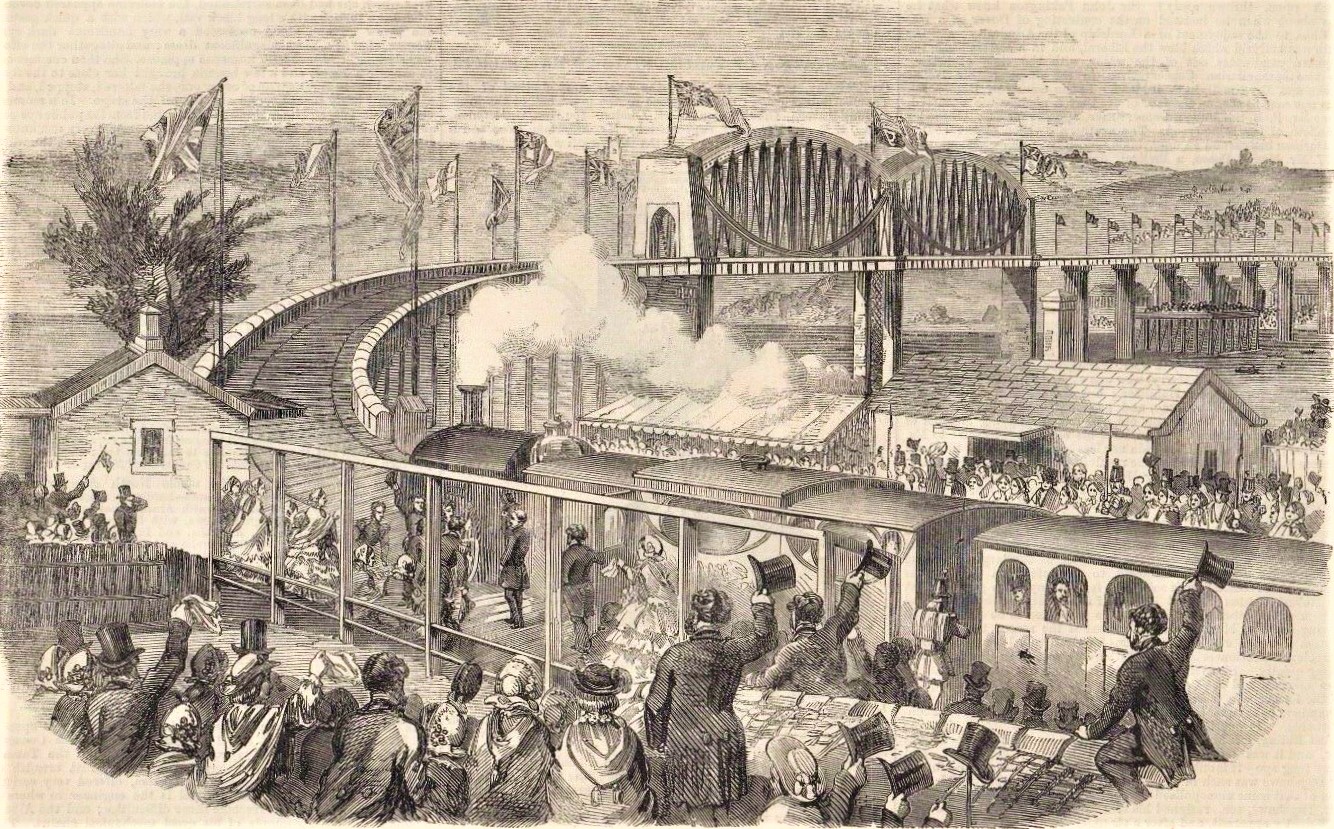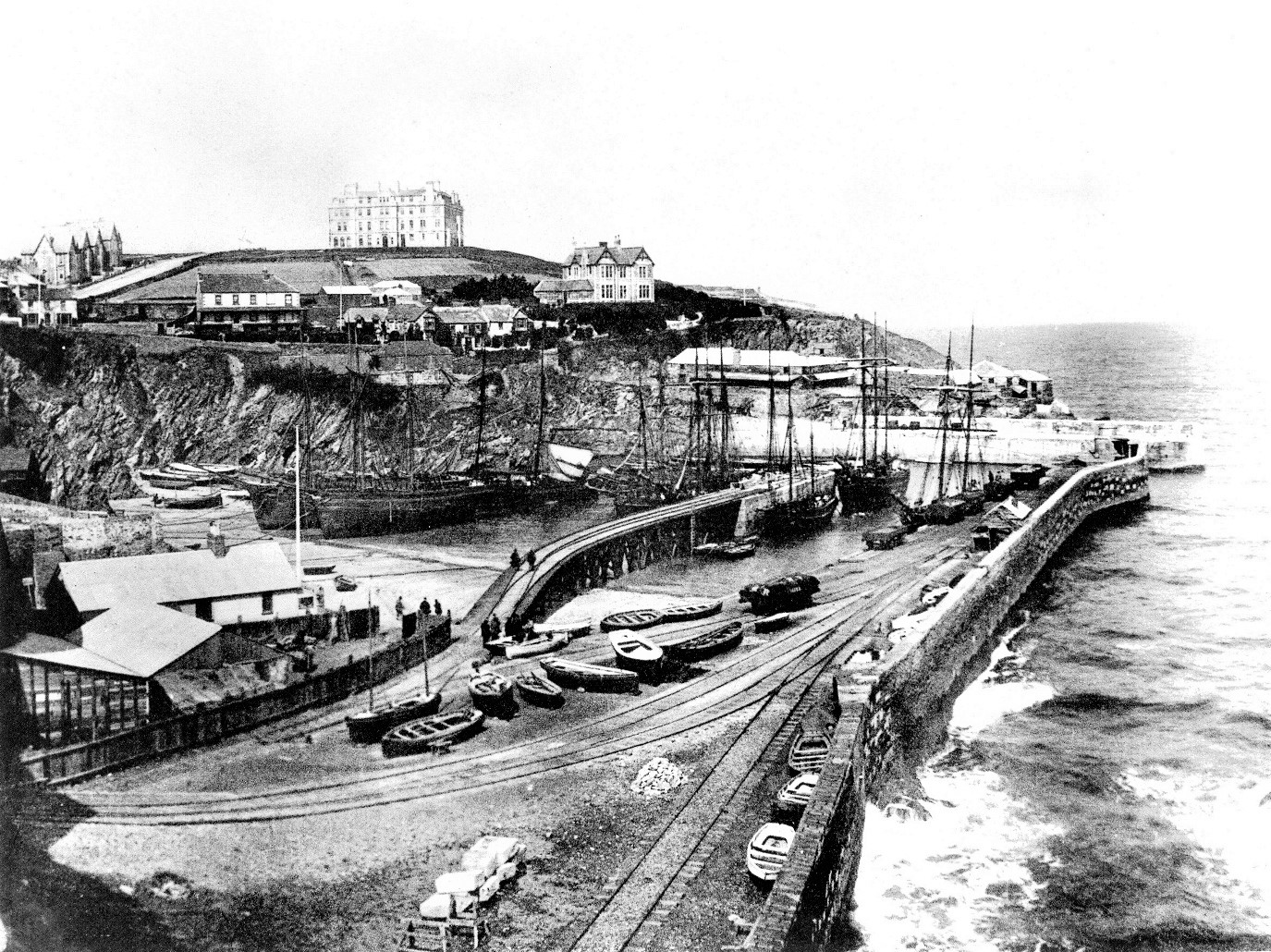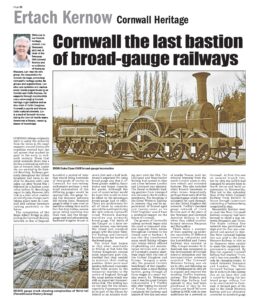Ertach Kernow - Cornwall the last bastion of broad-gauge railways
Cornwall's broad-gauge railways developed along the mainline linking those Cornish tramways originally built to carry the minerals from the mines to the small seaports around Cornwall’s coastline evolved into the rail system that reached its peak in the early to mid-20th century. From that point onwards there was a decline culminating with the loss of branch lines under the axe wielded by Dr Richard Beeching. Railways generally throughout the United Kingdom had been in decline for decades with 1,300 miles cut after World War I followed by a further 3,000 miles before Dr Beeching’s report in 1963. However, let’s look to a time when another period of great changes were taking place here in Cornwall and railway investors looking positively to the future.
The completion of the Royal Albert Bridge in 1859 joining the Cornwall Railway network to that of England heralded a period of time that would bring hundreds of thousands of tourist to Cornwall. For non-railway enthusiasts perhaps a very brief explanation of the differing gauges would be appropriate, the gauge being the distance between the railway lines. Standard gauge is what is now used on mainline railway lines and is 4 feet 8.25 inches, narrow gauge being anything less than that and the broad-gauge used and advocated by Isambard Kingdon Brunel at 7 feet and a half inch. Brunel’s argument for using broad-gauge was that it offered greater stability, faster trains and larger capacity for goods. Although the cost of construction would be more this would in time be offset by the advantages broad-gauge had to offer. There are preferences for all of these in countries around the world and during the 19th century Cornwall’s Great Western Railway mainline was primarily broad gauge. The ‘Battle of the Gauges’ as it later became known, was between the broad and standard gauges with the Great Western Railway and Cornwall becoming the last bastion of the broad-gauge.
As always click the images for larger view
The story had begun in 1833 when merchants in Bristol, at that time the United Kingdom’s second most important port city, decided that they needed to maintain their trading position. Other ports were gaining influence especially those with access to the industrial markets to the centre of England through the canal system which was still an important transportation link. The writing was on the wall for the canals, especially if passengers were to be part of the future for Bristol as an Atlantic trading port with the USA. The Liverpool and Manchester Railway had opened in 1830 and a line between London and Liverpool was planned. The threat to Bristol’s trading position from Liverpool was obvious to the Bristolian merchants. The founding of the Great Western Railway in January 1833 and its appointment of Brunel aged just twenty-seven as its Chief Engineer would have a profound impact on the future of Cornwall.
The genesis of Cornwall’s railway network began with the need to transport mineral deposits from mines throughout Cornwall to the closest port or harbour. It was this that transformed many small fishing villages into towns which offered shipbuilding and maintenance services and as part of Cornwall’s coastal maritime trade with the rest of the United Kingdom and Europe. Newquay is probably the greatest Cornish beneficiary of this transformation from a small fishing hamlet, going through all those stages to a major holiday resort. In Newquay’s case it was the great Cornish industrialist J T Treffry who after buying the manor of Towan Blystra which contained the harbour and hamlet of New Key and some of nearby Towan, built his mineral tramway from the south Cornish coast to this now rebuilt and extended harbour. This also included other branch tramways to other mines. Importantly perhaps these were all of the standard gauge which would ultimately be used throughout the United Kingdom rail network. Treffry’s standard gauge network of track became part of the plans of the Newquay and Cornwall Junction Railway in 1864 when they added another branch between Nanpean and Burngullow.
There were a number of lines opening up under the ownership of different investing companies and the Lostwithiel and Fowey Railway was opened in 1869. A major investor W. R. Roebuck was interested in the development of Cornish mineral extraction and the transportation network required. The Cornwall Minerals Railway was set up in 1872 and following an Act of Parliament in 1873 set to expand and improve the existing Treffry tramway system. The Bodmin and Wadebridge Railway had opened in 1834 had been purchased in 1847 by the London and South Western Railway (LSWR) with its own ambitions for a network in Cornwall. At first this was an isolated branch line, but by 1879 the LSWR had managed to acquire lines in North Devon and build an extension to Holsworthy. This led to the extended lines of the North Cornwall Railway from Halwill in Devon through Launceston and ending at Padstow being completed in 1899.
Meanwhile further west in 1846 the West Cornwall Railway company had been formed to build a line between Penzance and Truro. The Hayle railway line network was purchased in 1846 and the line was completed and opened in 1852. The West Cornwall Railway line was sold to the Great Western Railway in 1876 as its finances were unable to make the regulatory improvements required. By 1859 the separate Cornwall Railway had reached Truro, and it was now possible, but only by changing trains, to travel between Penzance and London. The West Cornwall Railway opened the St Erth to St Ives railway line on 1st June 1877 and is noted for being the last broad gauge railway line to be constructed in Cornwall. It formed part of the sale to the Great Western Railway and was ultimately converted to standard gauge between 21st and 22nd May 1892.
The Liskeard and Looe Railway was owned originally by the Liskeard and Looe Union Canal Company whose own origins began in 1827 with the aim of transporting sea sand and lime for agricultural purposes. The discovery of copper, tin and lead in the Caradon hills and its transportation needs overpowered the capacity of the canal, and the company built a railway line, completed in 1860. Due to declining mineral transportation during the late 1870’s the line began to carry passenger’s. To be effective it needed to link to the main line between Moorswater and Liskeard, which it did from 1901 and was operated by the Great Western Railway from 1909.
Already to ensure that passengers did not have to change from one train to another each with a different gauge many lines had mixed rails allowing both sized gauged trains to run. The Great Western Railway had gradually come to dominate Cornwall’s railway network but during the final decade of the 19th century the ‘Battle of the Gauges’ was won by the standard gauge. This led to all the broad-gauge lines being converted to standard-gauge with the last trains to be run on broad-gauge running on 20th May 1892. It was no doubt inevitable following the report from the Royal Commission on Railway Gauges in 1845 and the passing of the Railway Regulation (Gauge) Act 1846. This had set the railway line gauge at what was then called narrow gauge, now known as standard gauge. However, the Great Western Railway was excluded from this allowing it to run broad-gauge in Cornwall, south-west of England and to Wales. Although there were many tracks that combined both the standard and broad-gauged rails and could be used by trains and wagons of both gauges, considering the long-term connectivity of the GWR lines with the other rail companies throughout the United Kingdom was not practicable.
The task of converting the existing GWR broad-gauge lines to standard gauge took place over the weekend of Saturday 21st and Sunday 22nd May 1892 following much preparatory work. All the broad-gauge engines and rolling stock had been moved back to the GWR Swindon Works previously. Some 177 miles of track including both mainline and branches were narrowed from 7ft 0¼ins to 4ft 8½ins with around 4,700 men taking part in this huge project. The Sunday 'Night Mail' from Paddington ran right through to Penzance on time testifying to the successful completion of the work.
Following the end of World War One the Railways Act 1921 saw the majority of the railway companies in Great Britain grouped together into four main companies taking effect from 1 January 1923. The overall history of the GWR forms an important part of Cornish transport heritage. For the Great Western Railway the days of the Cornish Riviera Express and the delightful array of bright advertising tourism posters produced lay ahead. However, that’s a story for another day.
For those interested in Great Western Railway history and locomotives the GWR Museum located at the former Swindon Works has a fantastic range of engines and exhibitions. There is also the Didcot Railway Centre a railway museum and preservation engineering site at Didcot in Oxfordshire. This was formerly a Great Western Railway engine shed and locomotive stabling point.













